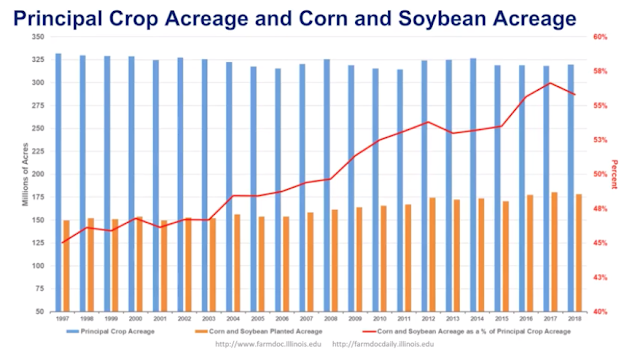Corn Acreage in 2019
read farmdocDaily article
The number of acres of corn planted this spring will be a key factor in determining where the price of corn goes. University of Illinois Agricultural Economist Todd Hubbs took up the issue in this week’s farmdocDaily article.
He starts with a historical graph. It shows the principal crop acres in the United States and how those have changed since 1997. Both corn and soybean acreage have increased. Combined they’re up about 10 percent over the past two decades.

Illinois’ Todd Hubbs uses that history to help put the number or corn and soybeans acres into perspective, “When we look at the harvest month corn to soybean futures price ratio this year it has been about 2.37. There is a definite signal in this graph from about 2006 to 2018 that if you are above 2.4 in that ratio, there will be less corn acreage. If you are below 2.3 there will be more corn acreage. We are today sitting right in between those. We’ve seen problems with fieldwork in large parts of the corn belt. We’ve seen fertilizer and other input costs go up on corn. So, the idea that we are going to see a massive increase in corn acreage could happen, but under the current price structure we might not see the kind of corn acreage we think we are going to see.”

Hubbs says he used the 2019–20 futures prices to forward calculate a seasons average cash price for new crop corn. His calculation points to $3.81 per bushel. He then figured a stocks-to-use ratio that would fit that number, “I think an 11% stocks to use ratio in 2019–2020 would give us $3.81. If consumption is constant at 14.8 billion bushels from this marketing year to the next, that would put corn acreage around 91.7 million at a national trend line yield of 174.6 bushels to the acre.”
Finally, Hubbs says there isn’t a lot of weather premium priced into new crop corn futures. He also says there isn’t much of premium built in for a possible trade deal with China. Hubbs thinks that may be just as bullish for corn as it is for soybeans. Right now he thinks the 2.37 soybean/corn ratio feels high if the expectation is for a substantial increase in corn acreage.

